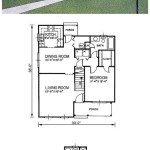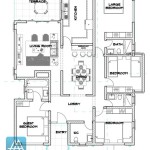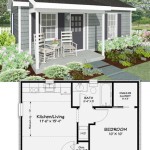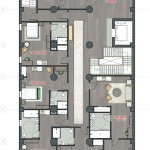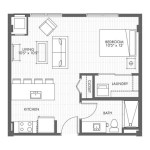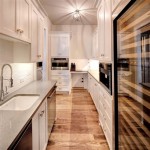What Is The Measurement in Floor Plan Design?
Measurement in floor plan design is a fundamental aspect of creating accurate and functional architectural representations. It involves the precise quantification of spaces, walls, openings, and fixtures within a building's layout. These measurements serve as the foundation for construction, renovation, and interior design projects, ensuring that the final built environment aligns with the intended design and meets the needs of its occupants. Accurate measurements are crucial for various stakeholders, including architects, builders, contractors, interior designers, and homeowners, as they inform critical decisions related to space planning, material selection, cost estimation, and code compliance.
The measurement process encompasses various dimensions, including lengths, widths, heights, and angles. These dimensions are meticulously recorded and translated into a scaled drawing, which forms the basis of the floor plan. The accuracy of these measurements directly impacts the usability and practicality of the space. Inaccurate measurements can lead to errors during construction, resulting in wasted materials, delays, and costly rework. Furthermore, incorrect dimensions can affect the functionality of the space, making it difficult to accommodate furniture, appliances, and other essential elements.
The units of measurement employed in floor plan design vary depending on geographical location and professional standards. In the United States, the customary system of inches and feet is commonly used, while the metric system, utilizing millimeters, centimeters, and meters, is prevalent in most other parts of the world. Regardless of the system used, consistency and precision are paramount. All measurements must be clearly labeled and accurately represented on the floor plan to avoid ambiguity and ensure clear communication among the project team.
The Importance of Accurate Measurement in Floor Plan Creation
The cornerstone of any successful floor plan design lies in the accuracy of its measurements. Without precise dimensions, the envisioned space can quickly deviate from its intended form, leading to a cascade of problems throughout the project lifecycle. Accurate measurements prevent costly errors during construction, ensures that materials are ordered in appropriate quantities, and facilitates the proper placement of fixtures and furnishings. This precision is not just about aesthetics; it's about functionality, safety, and adherence to building codes.
Consider, for example, the placement of doorways. Inaccurate measurements can result in doorways that are too narrow for wheelchair access, violating accessibility standards and hindering the free flow of movement. Similarly, incorrectly measured wall lengths can impact the placement of kitchen cabinets, appliances, and plumbing fixtures, leading to a dysfunctional and inefficient kitchen layout. The cumulative effect of these seemingly small errors can significantly impact the overall livability and value of the property.
Moreover, accurate measurements are essential for generating accurate cost estimations. Construction materials, such as flooring, drywall, and lumber, are priced per unit of measure. If the floor plan dimensions are inaccurate, the estimated material quantities will be incorrect, leading to budget overruns and financial strain. Contractors rely heavily on the precision of the floor plan to provide accurate bids, and discrepancies in measurements can create disputes and delays.
Furthermore, adherence to building codes and regulations is heavily reliant on accurate measurements. Building codes often specify minimum room sizes, ceiling heights, and clearances for various spaces. These requirements are designed to ensure the safety and well-being of occupants. Inaccurate measurements can lead to code violations, which can result in fines, project delays, and even the need for costly modifications to bring the building into compliance.
Tools and Techniques for Measuring Spaces
Various tools and techniques are employed to obtain accurate measurements for floor plan design. The choice of tool depends on the size and complexity of the space, as well as the level of precision required. Traditional measuring tools, such as measuring tapes and rulers, are still widely used, especially for smaller spaces and detailing. However, laser measuring devices and digital measuring tools are becoming increasingly popular due to their speed, accuracy, and ability to capture complex dimensions.
Measuring tapes are versatile and relatively inexpensive, making them suitable for a wide range of applications. However, they require careful handling to ensure accurate readings. The tape must be kept taut and aligned properly to avoid errors caused by sagging or twisting. Laser measuring devices, on the other hand, use a laser beam to measure distances quickly and accurately. These devices are particularly useful for measuring large spaces or areas that are difficult to access with a measuring tape. They can also calculate area and volume, further streamlining the measurement process.
Digital measuring tools, such as digital calipers and angle finders, are used to measure precise dimensions and angles. These tools provide highly accurate readings and can be easily integrated with computer-aided design (CAD) software. CAD software is an essential tool for creating and modifying floor plans. It allows architects and designers to draw accurate representations of spaces, incorporate measurements, and generate detailed construction documents.
In addition to selecting the appropriate tools, proper measuring techniques are crucial for obtaining accurate results. It is important to take multiple measurements and verify them to minimize the risk of errors. When measuring walls, it is necessary to account for irregularities and ensure that the measurements are taken along a consistent plane. For complex spaces, it is helpful to create a sketch of the area and label each dimension clearly. This sketch can serve as a reference during the measurement process and help to organize the data.
Impact of Measurement Accuracy on Construction and Design Outcomes
The accuracy of measurements directly impacts the ultimate success of both the construction process and the overall design outcome. Accurate measurements serve as a blueprint for the construction team, guiding their work and ensuring that the finished building aligns with the architect's vision. Errors in measurement can lead to misaligned walls, improperly sized rooms, and other deviations from the original design, which can be costly and time-consuming to correct.
During the construction phase, accurate measurements are essential for ensuring that materials are cut to the correct size and installed properly. For example, if the dimensions of a room are inaccurate, the flooring may need to be cut to a different size, leading to wasted material and increased labor costs. Similarly, inaccurate measurements can affect the placement of windows and doors, potentially compromising the structural integrity of the building and impacting its aesthetic appeal.
From a design perspective, inaccurate measurements can undermine the functionality and aesthetic appeal of the space. If the dimensions of a room are smaller than intended, it may not be able to accommodate the desired furniture and fixtures. This can lead to a cramped and uncomfortable living environment. Conversely, if the room is larger than anticipated, it may feel empty and impersonal.
The proper integration of furniture and fixtures into the space is highly dependent on accurate measurement. Interior designers rely on precise dimensions to select furniture that fits comfortably within the room and complements its overall design. Inaccurate measurements can result in furniture that is too large or too small for the space, disrupting the balance and flow of the design. Similarly, the placement of lighting fixtures, outlets, and other electrical components is dependent on accurate measurements to ensure that they are positioned correctly and meet the needs of the occupants.
In summary, the accuracy of measurements in floor plan design is paramount. It ensures the functionality, cost-effectiveness, and aesthetic appeal of the final product. By employing the correct tools and techniques, professionals and individuals alike can minimize errors and create spaces that are both practical and visually pleasing.

How To Read A Floor Plan With Dimensions Houseplans Blog Com

How To Properly Read Floor Plans And What Details Look For

A Floorplan Of Single Family House All Dimensions In Meters Scientific Diagram

How To Read A Floor Plan

How To Read Floor Plans With Dimensions A Guide

12 Examples Of Floor Plans With Dimensions

Floor Plans With Dimensions Including Examples Cedreo

How To Read Floor Plans With Dimensions A Guide

How To Read A Floor Plan With Dimensions Houseplans Blog Com

How To Read Floor Plans With Dimensions A Guide
Related Posts


